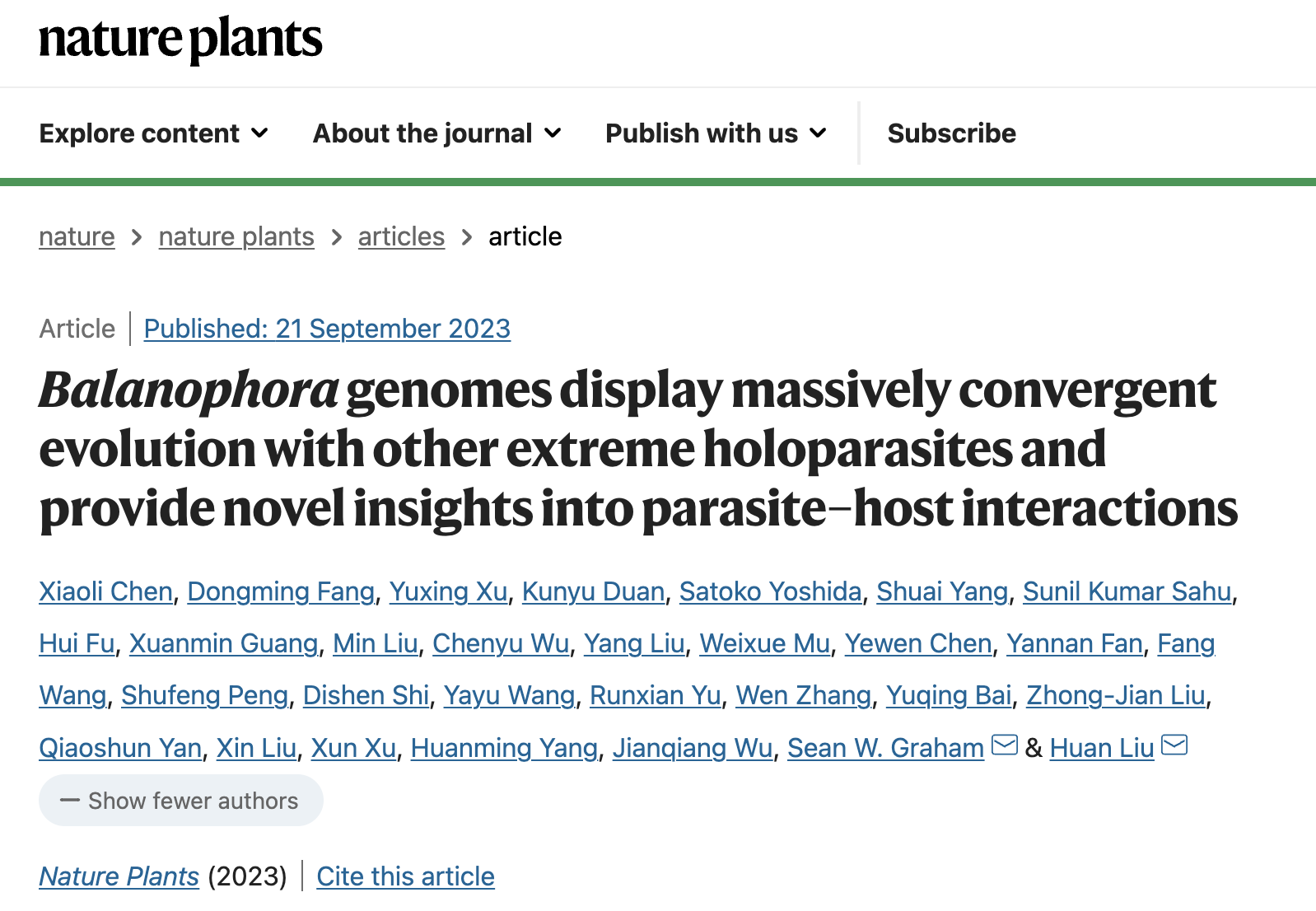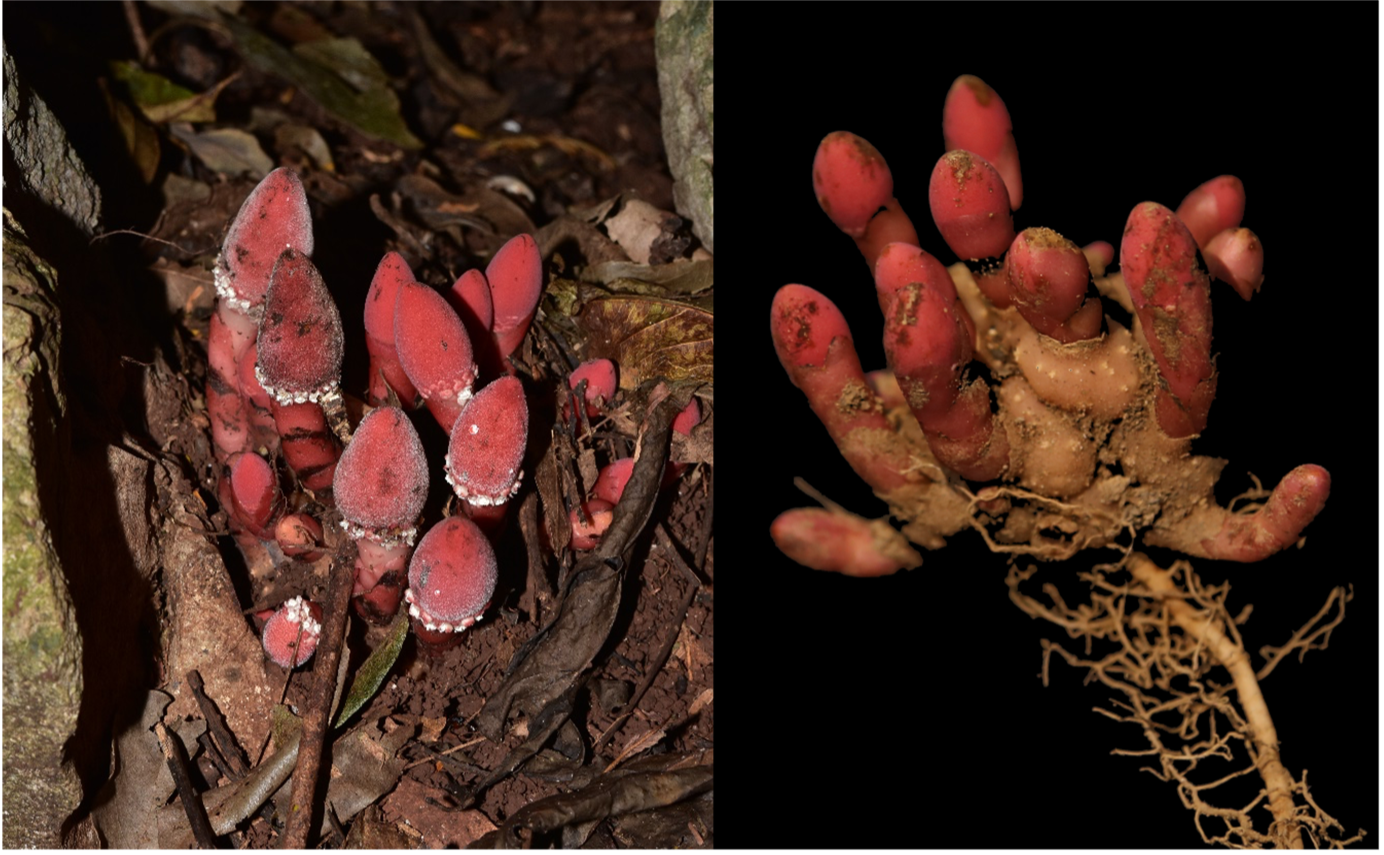In research published on 21st September in Nature Plants, scientists from BGI-Research, Kunming Institute of Botany, the University of British Columbia, and others, shed light on the impact of genomic adaptations on the evolution of plant parasitism through studying Balanophora, a holoparasitic plant that is not capable of photosynthesis and obtains all nutrients and water from its host plant.
 The research “Balanophora genomes display massively convergent evolution with other extreme holoparasites and provide novel insights into parasite–host interactions” published in Nature Plants.
The research “Balanophora genomes display massively convergent evolution with other extreme holoparasites and provide novel insights into parasite–host interactions” published in Nature Plants.
In general, plants are autotrophic organisms capable of photosynthesis. However, there are approximately 5,000 plant species that have evolved to rely on other host plants for sustenance, and some of them even lose their ability to photosynthesize.
Balanophora had captured the interest of the BGI researchers during the 10,000 Plant Genome Project (10KP). Dr. Xiaoli Chen, a researcher at BGI-Research and lead author of the paper, explains: “We wondered what happened after they evolved to become holoparasites, when they lost the most important function that normally defines green plants – the ability to photosynthesize.”
The research team assembled and analyzed genomes of members of the sandalwood order, including a stem hemiparasite, Scurrula, and two Balanophora root holoparasites. The genome comparison showed that the Scurrula and other hemiparasites, with moderate degree of parasitism, experienced a relatively minor degree of gene loss compared to autotrophic plants. In contrast, Balanophora, experienced substantial gene loss.
By comparing Balanophora with Sapria, another extreme parasitic plant in a different family, the scientists were able to observe the same substantial gene loss. “The extent of common gene loss observed in Balanophora and Sapria is striking,” says Dr. Chen. “It points to a very strong convergence in the genetic evolution of holoparasitic lineages, despite their outwardly distinct life histories and appearances, and despite their having evolved from different groups of photosynthetic plants.”
 Left: the morphology of Balanophora subcupularis and their habits. (Photo by Ze Wei, Plant Photo Bank of China) Right: the above-ground tissues (mainly flower stem and inflorescence), below-ground named tubers, and the root of the host. (Photo by Xiaoli Chen, BGI-Research)
Left: the morphology of Balanophora subcupularis and their habits. (Photo by Ze Wei, Plant Photo Bank of China) Right: the above-ground tissues (mainly flower stem and inflorescence), below-ground named tubers, and the root of the host. (Photo by Xiaoli Chen, BGI-Research)
In addition to the near total loss of genes associated with photosynthesis, the scientists also found a loss or shedding of genes in other key biological processes, such as root development, nitrogen absorption, and regulation of flowering development. This supports the idea that holoparasites only keep the genes that are essential to them and eliminate those that have become unnecessary or redundant.
Transcriptome data also documented unusual and novel interactions between Balanophora and its host plant and the host–parasite tuber interface tissues, with evidence of mRNA exchange, substantial and active hormone exchange and immune responses in parasite and host.
For example, while genes related to the synthesis of a major plant hormone, abscisic acid (ABA), which is responsible for plant stress responses and signalling, had been lost in Balanophora and Sapria, the researchers still found accumulation of the ABA hormone in flowering stems of Balanophora and that genes involved in the response to ABA signalling were still retained in these holoparasites. This suggested that the parasites are capturing and using the ABA hormone synthesized by their host plants.
According to Dr. Sean Graham, Professor of Botany at the University of British Columbia, and an author of the paper: “The majority of the lost genes in Balanophora are probably related to functions essential in green plants, which have become functionally unnecessary in holoparasites. That said, there are probably instances where the gene loss was actually beneficial, rather than reflecting a simple loss of function. The loss of their entire ABA biosynthesis pathway may be a good example of this, as it may help them to maintain physiological synchronization with the host plants. This needs to be tested in the future.”
This research lays the foundation for further investigation into the mysteries of plant parasitism, their evolutionary adaptations and genetic intricacies. Dr. Huan Liu, a researcher at BGI-Research and the corresponding author of the paper, explains: “The study of parasitic plants deepens our understanding of dramatic genome alterations and the complex interactions between parasitic plants and their hosts. The genomic data provides valuable insights into the evolution and genetic mechanisms behind the dependency of parasitic plants on their host, and how they manipulate host plants to survive.”
Read the article: https://www.nature.com/articles/s41477-023-01517-7



